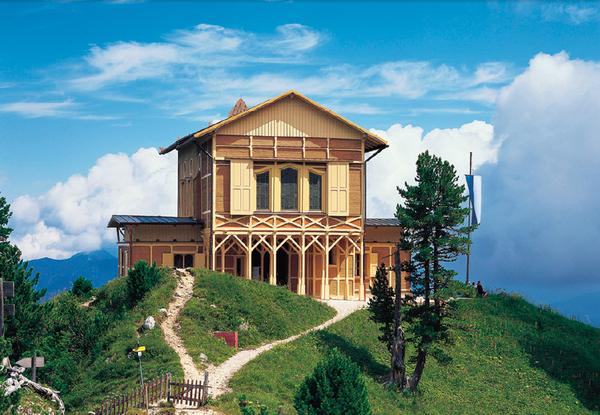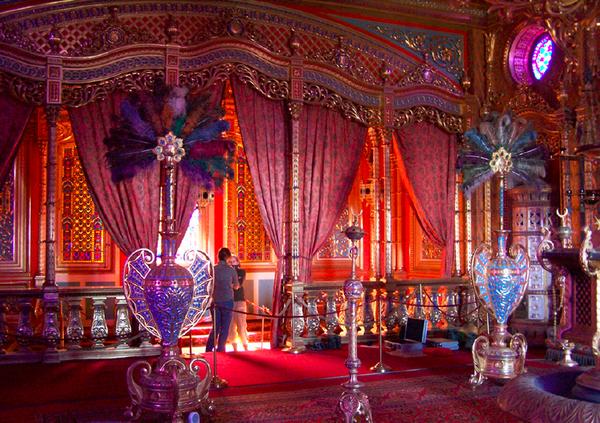Climate change is endangering centuries-old murals and frescos, paintings, furniture and fabrics. Can this deterioration be halted? Researchers are searching for solutions in an EU project entitled “Climate for Culture”.
Research can be heavy going - especially when the object of study is 1,868 meters above sea level. The hike to the King’s House on Schachen takes three hours. Ralf Kilian would be able to find his way there in his sleep. He has been marching up it regularly - initially to attach sensors and later to read off measurements. What an atmosphere for climatology: a fairy tale palace from 1001 Arabian Nights. Ludwig II, King of Bavaria, had the building constructed at the end of the 19th century for extravagant oriental parties. The upper floor of the wooden house features an abundance of stained glass windows, Persian carpets, golden chandeliers, fans of ostrich plumes and even a fountain.
Kilian and his colleagues from the Fraunhofer Institute for Building Physics IBP in Holzkirchen, Germany, have installed more than a dozen sensors to measure the relative humidity and temperature in the Turkish Room of the King’s House over the years. In addition, highly sensitive glass sensors - developed by the Fraunhofer Institute for Silicate Research ISC in Würzburg - are in place to detect airborne pollutants and microorganisms. In order to compare interior measurements in outdoor conditions, a weather station was constructed in the garden to regularly transmit weather data on wind, sunshine, precipitation and temperature. “With the help of this data, we can accurately document and evaluate changes in indoor conditions over the course of the year,” reports the researcher.
The surprising outcome: despite the rough conditions high up in the Wetterstein Mountains, the relative humidity in the King’s House on Schachen remains stable between 40 and 70% for the most part, a range considered acceptable for museums and collections. The murals, carpets and furniture are in fact quite well preserved. Fortunately. Other historical buildings that the researchers have investigated, such as Linderhof Palace, are in a much worse shape. The plaster is crumbling, and paint and gilding are flaking off from the underlying surface. The cause of this is the drastically rise in humidity resulting from the breath and perspiration of thousands of visitors.
The measurements taken in the royal Bavarian castles and palaces a small but important piece of the puzzle as far as the EU project “Climate for Culture” is concerned. 27 teams from 14 countries in the EU as well as Egypt have examined more than 100 cultural monuments - including Skokloster Castle in Sweden, a Slovenian fort in Brežice, an English manor house in Knole, a private Venetian villa and a Norwegian wooden-pillared church in Garmo. Florian Antretter from Fraunhofer IBP used specialized software called WUFI®Plus to simulate the interior climate based on the measurement data recorded at these various locations. The results document how different climatic conditions affect the state of buildings and works of art throughout Europe.
With the help of the enormous database created, the researchers are now able to look into the future. The aim of “Climate for Culture” is to predict the effects climate change will have on cultural assets. Due to the combustion of fossil fuels, the concentration of carbon dioxide in the atmosphere has been climbing ever since the start of the industrial revolution. The models developed by climatologists demonstrate that these greenhouse gases produce extreme weather events, as well as causing a rise in sea level and a shift in climatic zones. The initial changes are already being observed - an indication that the simulations are correct - and are expected to intensify in the future. However, climate change can have quite different effects regionally. The models developed by researchers at the Max Planck Institute for Meteorology in Hamburg demonstrate that it will become hotter and dryer in the Mediterranean but much wetter in northern Europe, especially between the North Sea and the Baltic above the 55th degree of latitude. Risk maps of Europe worked out by the international interdisciplinary research team show what these forecasts mean in detail, even for areas as small as 10 km x 10 km. Detailed climate predictions of hourly temperature and humidity right up to the year 2100 can be called up for every one of the more than five hundred grid points.
Coupled with the indoor climate simulations of the WUFI software, the consequences of climate change can be predicted in detail. "The combined model provides us with prognoses about the temperature and humidity values that will predominate inside historical buildings at a particular place," explains Prof. Klaus-Peter Sedlbauer, Institute Director of IBP. "If the climate models for southern England predict a three-degree rise in the average temperature and an increase in humidity of ten percent, then the software sends a warning of a heightened risk of mold growth based on the data gathered in the project, for example. In southern Europe, on the other hand, where conditions will become dryer, there is a risk that objects will become damaged because they could dry out too much.”
The model even permits travel through time and space. With the click of a mouse, the scientists can catapult the Church of St. Margaretha in the Bavarian village of Roggersdorf into the year 2050 and move it to Provence or to a Norwegian fjord. The simulation program promptly provides values for temperature and humidity in the interior resulting from this displacement in time and space. The type of construction is also taken into account. The climate inside the church, with its thick walls and small windows, differs from that inside a building that is flooded with light such as Schönbrunn Palace in Vienna. All the information resulting from these virtual journeys has been collected by the researchers to form a database. due to go online towards the end of 2014. “Owners of castles and palaces, as well as administrators of museums and collections, can not only enter their location but also select the characteristics of the respective buildings. They then receive predictions about the climate changes expected up to the year 2100 and the consequences these will have, all free of charge," explains Dr. Johanna Leissner, coordinator of the EU project. At the same time, the database provides recommendations about how to protect works of art from deteriorating, and how much it would cost if increased heating or cooling is necessary.
These results are especially useful for those considering renovations, emphasizes Leissner: “If costly steps are going to be taken, then the interior conditions should be stabilized to preclude further damage.” The Bavarian Administration of State-Owned Palaces, Gardens and Lakes already intends to use the results of the project for the renovation measures planned for Linderhof Palace.
At the King’s House on Schachen, nothing will be changed. The Turkish Room will remain in pristine condition. The double-walled construction of the wooden structure and its secluded location have a positive effect on the indoor climate. The impact of large numbers of visitors on the interior climate in Neuschwanstein is not a problem when it comes to Schachen - for many people, the trade-off of the climb is not worth it.
Text: Monika Weiner

